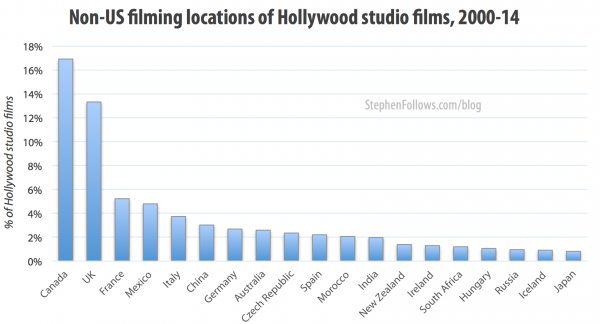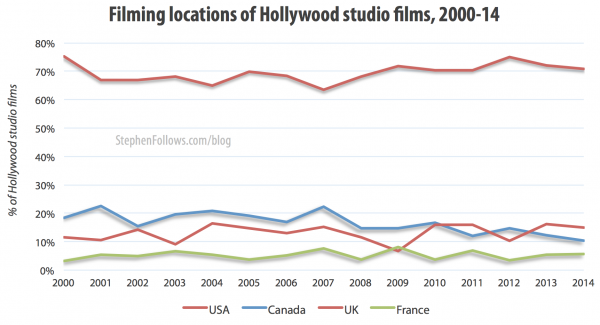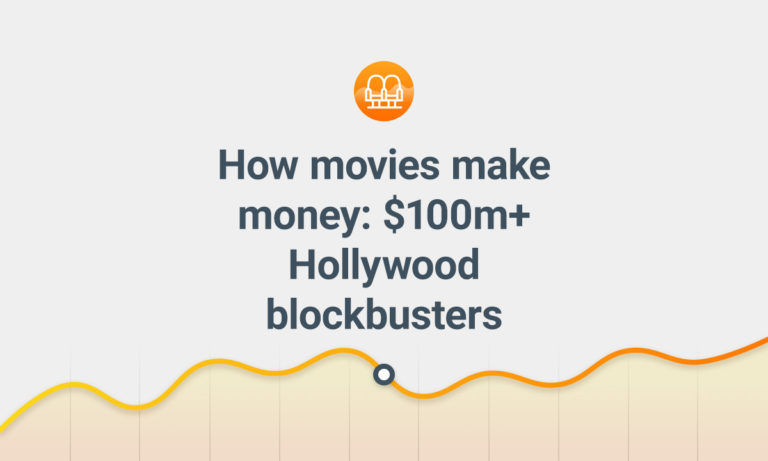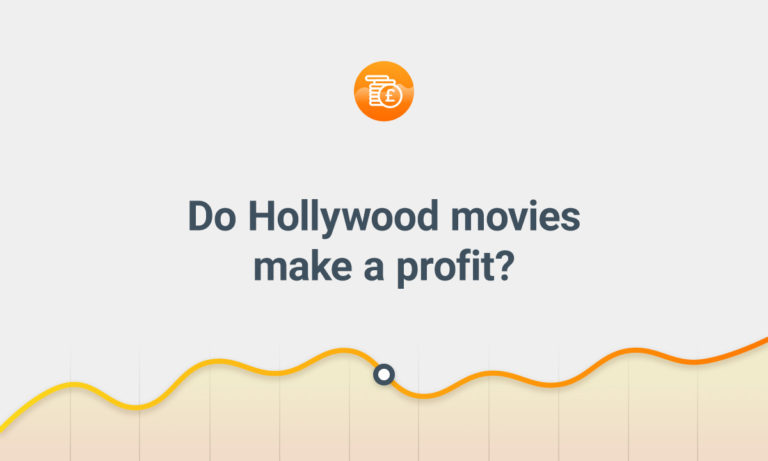 As part of my research into the film business in China last week, I started to look at which countries Hollywood films are shot in. I expected to see an increase in films being shot in China in order to appease the state, however I found no such pattern. One side-effect is that I was able to extend my research to other countries. In summary…
As part of my research into the film business in China last week, I started to look at which countries Hollywood films are shot in. I expected to see an increase in films being shot in China in order to appease the state, however I found no such pattern. One side-effect is that I was able to extend my research to other countries. In summary…
- 48% of Hollywood films are shot exclusively in America
- 28% are shot entirely outside of the USA
- In 2014, 15% of Hollywood films were shot in part in the UK
- The UK has taken over from Canada as most popular non-US Hollywood movie locations
- Films set in New York are often shot in Toronto
- 71% of films shot in Iceland between 2000-14 were ‘Adventure’ films
These figures relate to the 2,088 live action scripted feature films released by Hollywood studios between 2000 and 2014. (There are more details about the films and some caveats about the data in the final section below).
Born in the USA, mostly
In 2014, just under half of all hollywood films were shot exclusively the USA with a further 24% being filmed in the USA and other countries. Only 28% of films had their entire principal photography outside of the USA. 
Beyond the shining seas
Of the films which had some non-US filming, Canada and the UK were the most popular destinations. 
 Canada has long been a destination for Hollywood films looking for cheaper production costs, known as ‘runway productions’. There is an old Hollywood adage that parts of Canada can double for America – Toronto looks like New York, Vancouver like middle America and, at a push, Calgary is a bit like the American West. The truth of the matter is that these places don’t really look the same but decades of Hollywood telling us they do has meant that cinema audiences can’t tell the difference. As Lenin once said “A lie told often enough becomes the truth”.
Canada has long been a destination for Hollywood films looking for cheaper production costs, known as ‘runway productions’. There is an old Hollywood adage that parts of Canada can double for America – Toronto looks like New York, Vancouver like middle America and, at a push, Calgary is a bit like the American West. The truth of the matter is that these places don’t really look the same but decades of Hollywood telling us they do has meant that cinema audiences can’t tell the difference. As Lenin once said “A lie told often enough becomes the truth”.
 The UK currently has a very generous tax system, which gives Hollywood studios close to a fifth of the money they spend in the UK back in cash. They don’t need to repay this money or share any of the profits. The UK also has highly experienced studios, crews and post-production facilities. (We also have rather good tea). In recent years, the UK has overtaken Canada to be the top non-US country for the filming of Hollywood films.
The UK currently has a very generous tax system, which gives Hollywood studios close to a fifth of the money they spend in the UK back in cash. They don’t need to repay this money or share any of the profits. The UK also has highly experienced studios, crews and post-production facilities. (We also have rather good tea). In recent years, the UK has overtaken Canada to be the top non-US country for the filming of Hollywood films.  Not everyone is happy with the studios’ peripatetic plans. JJ Abrams complained bitterly and publicly about having to move his family to a place far, far away to shoot the new Star Wars film (i.e. London).
Not everyone is happy with the studios’ peripatetic plans. JJ Abrams complained bitterly and publicly about having to move his family to a place far, far away to shoot the new Star Wars film (i.e. London).
Horses for courses
Different types of films require different types of landscapes. 71% of films shot in Iceland between 2000-14 were adventure films, compared with just 28% of films shot in the UK. 
Data & Caveats for Hollywood movie locations
The data for which films to include came from the National Association of Theatre Owners (NATO). I then used various public online sources to determine shooting locations including IMDb, Wikipedia, Movie Locations, Seeing Stars, Movie Locations Guide and British Film Locations. The 2,088 films were all released in US cinemas by a Hollywood studio between 1st January 2000 and 31st December 2014. The studios I included were…
- Warner Bros.
- Universal
- Sony
- Paramount
- New Line*
- MGM*
- Lionsgate
- Fox
- DreamWorks
- Disney
* N.B. New Line stopped distribution in 2007 and MGM in 2009. Today’s data comes with a few notes and caveats…
- Volume of shooting – I am not able to determine the volume of shooting in each country, meaning that a film which shoots 70% in one country and the remaining 30% in two other countries will just show up as having 3 country locations in my data. Many films will shoot the vast majority of the film in one country and then just take a small trip to another country or send a second unit.
- Release date – The years shown the charts above relate to the year in which the films were first released in cinemas. This means that they don’t relate to the date of filming or, most crucially if you work in tax policy, to when the decision was made to film in a certain country. Therefore, we cannot use the year-on-year changes in productions to illustrate the effect of a change in tax incentives.
- Full data – I have no way of knowing if the information available online is complete. I could not find verifiable location information for 2% of the films.
- Genre – I have assigned up to three genres per film
- Types of films – I excluded all documentaries and entirely animation-based films.
Epilogue
 Last week I was interviewed by Mark Kermode for a BBC Radio 4 series called ‘The Business of Film’. One of the topics that came up was the ‘Britishness’ of the Hollywood films that have flocked to the UK in recent years. Plus when I turned up to the studio I caught the end of Mark quizzing Matthew Vaughn about Harvey Weinstein and from what I heard it’s going to be a show worth catching. The three-part series will be broadcast from late February.
Last week I was interviewed by Mark Kermode for a BBC Radio 4 series called ‘The Business of Film’. One of the topics that came up was the ‘Britishness’ of the Hollywood films that have flocked to the UK in recent years. Plus when I turned up to the studio I caught the end of Mark quizzing Matthew Vaughn about Harvey Weinstein and from what I heard it’s going to be a show worth catching. The three-part series will be broadcast from late February.





Comments
Not accounting for volume of shooting is a major problem that makes some of the conclusions you reach…problematic. For example, Saving Mr. Banks (2013) shot all but a single day in California. Thus, a single day of shooting in London means this counts to making the UK a more popular destination than Canada? Time filming and amount spent are vastly more important. Should one day of filming on Banks count as a film for the UK as much as a film like Robocop (2014) or Godzilla (2014) which both shot almost entirely in Canada with only minimal work done in the US?
Where a film spends most of its time and, more importantly, most of its money is much more critical than the “filming locations” listed on imdb. In the last several years, US production spending in Canada has surpassed US film spending in the UK by several hundred million or more (even accounting for currency).
On another note, can you make the databases you created available online? It would be nice to see the movies and their respective data. It also looks like the studios you included also meant their subsidiaries, is that correct? Making the info available via a shared excel file etc would answer questions like this.
I agree – it’s a shame I can’t account for the length of time, nor which unit is filming, hence the rather long caveats section in the article. Many of the topics I look at are subjective or the very act of collecting the data influences the result. The way I try to detail with this is to be open with my methodology and highlight any restrictions or biases I can see. My hope is that all readers are empowered enough to draw their own conclusions, rather than just accept my commentary wholesale.
I not against releasing data I’ve collected per se (in fact I have a new project launching in a few weeks which does explicitly that) but in cases like this I have been advised against doing so. You can’t copyright a fact but it get dicey when you start having collections of facts, such as a database. I build on existing work as well as doing my own research. So as not to infringe on anyone else’e property, I tend to only release the full data on the work that is entirely primarily my own.
That said, I have a long history of helping other researchers so feel free to drop me a line and we can chat.
Will do. And don’t get me wrong, you do fantastic work.
PS– did you read this report from last year? http://goo.gl/4SR7I3
I think your statement “for example, Saving Mr. Banks (2013) shot all but a single day in California. Thus, a single day of shooting in London means this counts to making the UK a more popular destination than Canada? Time filming and amount spent are vastly more important.” can be looked at two-fold.
The first, how much money did the film actually put into the economy of the country being filmed in, which is the typical reasoning first thought of. Which is where your statement is absolutely sound – as a single day of shooting is negligible at best.
And the second, from a marketing perspective, is there a benefit to the country – even if only filmed in for one day – that would heighten tourism to that country. There is actually quite a bit of research done on that fact alone, and the benefits a country derives financially after a film is released, that really should be even more so capitalized on by film commissions when making tax credit decisions.
Take a look at this article as a quick example. http://www.hawaiibusiness.com/filming-movies-in-hawaii-boosts-economic-impact-and-tourism/
Film Location Impact of visitor number
Braveheart Wallace Monument,
Scotland
300% increase a year after release
Captain Corelli’s
Mandolin
Cephalonia, Greece 50% increase
Field of Dreams Iowa 35,000 visits in 1991 and steady increase every year
Four Weddings and aFuneral
The Crown Hotel,
Amersham, England
Fully booked for at least 3 years
Harry Potter Various locations in UK Increase of 50% or more in all filmed locations
Mission Impossible 2 National Park, Sydney 200% increase in 2000
Notting Hill Kenwood House, England 10% increase in one month
Pride and Prejudice Lyme Park, England 150% increase
Sense and Sensibility Saltram House, England 39% increase
The Beach Thailand 22% increase in youth market in 2000
Troy Canakkale, Turkey 73% increase
I was wondering how to get involved in the movie shoot industry involing past and present security
Would be interesting to see this done for visual effects. Location where visual effects are done are frequently determined by subsidies, in many cases independent of filming location. Visual effects can also account for a sizable percent of the film budget (20-50% for large visual effects films)
The UK tax benefits are not the only reason we plan to make “Christopher Marlowe” there. We’re and American-owned UK film production company and wouldn’t think of making this Elizabethan-era spy thriller any place else.
https://www.facebook.com/ChristopherMarloweMovie
Stephen – you WILL be seeing a lot of films shot in China. This year Warner Bros brought Geostorm to China to shoot a few scenes, 20th Century Fox created a story line that features China in The Martian – with potentially some of that shot in China as well versus in Hungary, Transformers of course…
We keep our eyes out for film properties our Chinese brand clients will get excited about, and we are definitely seeing a trend where either the location has scenes filming in China, appearing to be set in China, or a key positive role played by one or more Chinese characters.
This will definitely be a growing practice in the years to come as Hollywood film studios work to leverage interest by the Chinese government to allow their films to be shown in the soon-to-be-bigger-than-the-US Chinese box office.